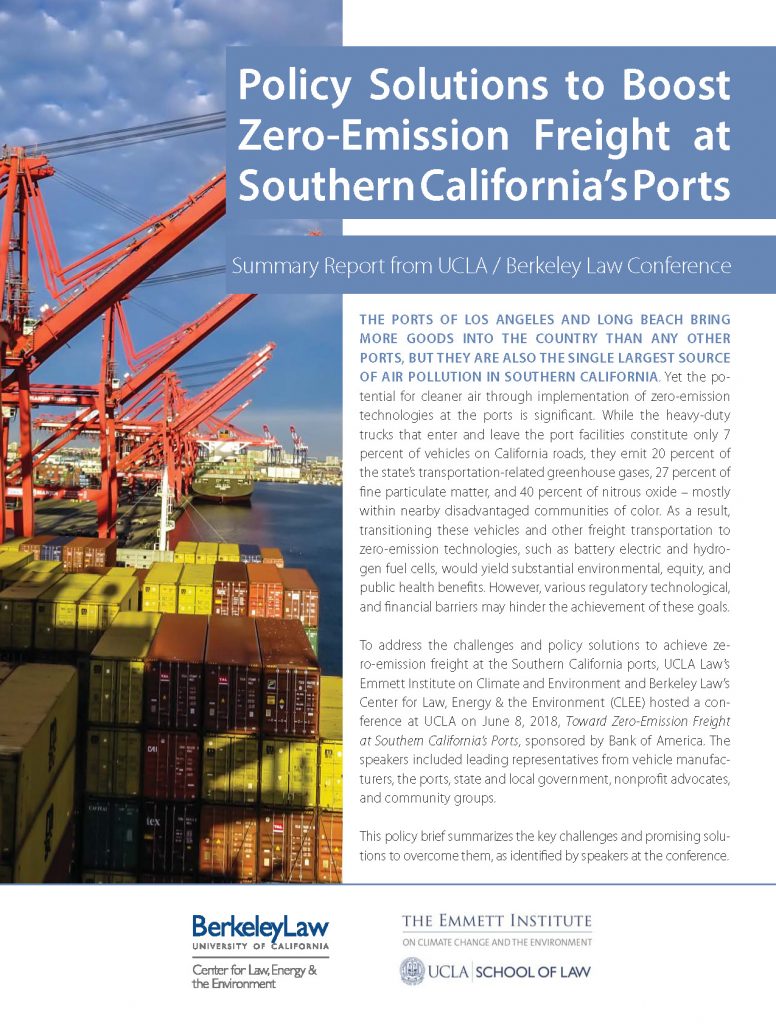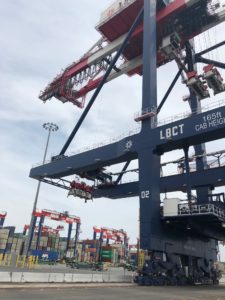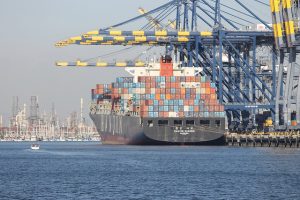
The Ports of Los Angeles and Long Beach are major polluters in the region but also potential models for climate action — if they can electrify their equipment, from fork lifts to cranes. A new report released by UCLA Law’s Emmett Institute on Climate Change and the Environment and UC Berkeley Law’s Center for Law, Energy & the Environment (CLEE) —A Heavy Lift: Policy Solutions to Accelerate Deployment of Zero-Emission Cargo Handling Equipment at the Ports of Long Beach and Los Angeles and Beyond—surveys the biggest obstacles to speedy electrification and makes some recommendations.
Greenhouse gas emissions at the Ports come from three main sources: ships, heavy-duty vehicles, and cargo handling equipment (“CHE”). Cargo handling equipment is the third largest source of emissions accounting for approximately 14 percent of the Ports’ total greenhouse gas emissions. The Ports have replaced some fossil-fuel powered equipment with zero-emission models as they work toward goals set forth in their Clean Air Action Plan, including a goal to transition to 100 percent zero-emission CHE by 2030. However, more work is needed to fully transition the Ports large CHE fleet to zero-emission models. While some consider cargo handling equipment the “low hanging fruit” of port emissions reductions, there remain challenges for the transition to zero emissions. Some of the needed ZE technology is still being developed, and communities and workers have raised concerns around the potential for job loss.
To address these concerns, the law schools hosted a convening of experts from a variety of industries, including environmental, public health, environmental justice, labor, business, and government sectors. We discussed the challenges and opportunities of decarbonizing cargo handling equipment at the Ports. The report discusses the top barriers to transitioning to electric CHE models and proposes solutions to overcome these barriers.
The report dives into the following barriers:
- Inadequate grid and charging infrastructure to support zero-emission cargo handling equipment and lack of substantial planning and funding to install necessary and timely infrastructure.
- Evolving zero-emission technology for some types of cargo handling equipment and high upfront costs.
- Fear among communities and workers of job loss and of increased emissions from expanded port activities.
The report then recommends several solutions, including:
- The Ports and utilities, chiefly Southern California Edison and Los Angeles Department of Water and Power, could proactively deploy “no regret” infrastructure, including increasing grid capacity and upgrading distribution networks that will be needed regardless of how zero-emission cargo handling equipment is powered.
- The California Legislature; the Air Resources Board; and/or the South Coast Air Quality Management District, using their existing authority grounded in air pollution control, could create technology-forcing mandates and clear, enforceable implementation deadlines, with penalties for non-compliance, to catalyze the zero-emission cargo handling equipment transition. Where technology is not readily commercially available, regulations could incorporate adequate flexibility and sufficient lead time for entities to meet the mandate.
- State and local government could implement policies to promote job preservation, local job creation, and worker training, such as programs that encourage ports and terminal operators to partner with local training organizations to upskill and reskill the workforce to use the new vehicles and technologies.

Given the importance of the Ports to worldwide commerce, they could help inform climate action at ports around the globe, if they and policy makers can collaborate to achieve these zero-emission goals.
If you want to dive into this topic further, join us for a webinar discussion today, Thursday, November 16th at 1pm PT when we’ll discuss solutions with panelists from Southern California Edison, the Port of Los Angeles, and Earthjustice (RSVP here).
This report is ultimately part of a series on business solutions to address climate change. Read more: A Heavy Lift: Policy Solutions to Accelerate Deployment of Zero-Emission Cargo Handling Equipment at the Ports of Long Beach and Los Angeles and Beyond.
This post was co-authored by Beth Kent and Gabi Rosenfeld.
The HHLA Container Terminal Altenwerder (CTA) in Hamburg, Germany, features an automated handling facility using low and zero-emission equipment, similar to the Port of Long Beach. This video shows the cutting-edge technology and attendant environmental benefits:
It’s easy to see why labor groups fear the automation technology, as no workers are now needed in this facility. And it also points to the continued need to deploy zero-emission trucks, as once the cargo leaves the facility, it’s still carried by dirty trucks polluting nearby neighborhoods.
 UCLA and UC Berkeley Schools of Law have released a new policy brief that describes the top challenges and solutions for deploying zero-emission freight technologies at Southern California’s ports. Policy Solutions to Boost Zero-Emission Freight at Southern California’s Ports summarizes the key findings from a conference on the topic at UCLA on June 8th.
UCLA and UC Berkeley Schools of Law have released a new policy brief that describes the top challenges and solutions for deploying zero-emission freight technologies at Southern California’s ports. Policy Solutions to Boost Zero-Emission Freight at Southern California’s Ports summarizes the key findings from a conference on the topic at UCLA on June 8th.
The Ports of Los Angeles and Long Beach bring more goods into the U.S. than any other port in the country. Yet together they represent the single largest source of air pollution in Southern California. While harbor commissioners have adopted an ambitious plan to transition to cleaner fuels for port-based freight in the next two decades, achieving the vision will require hard work.
The brief summarizes the top three challenges to deploying zero-emission technology at the ports, such as battery-powered trucks, as discussed by speakers at the conference:
- Lack of charging and fueling infrastructure deployment
- Uncertainty regarding technological and economic feasibility of zero-emission technology
It then describes the top solutions (more detail in the policy brief) that speakers raised:
More infrastructure funding and community engagement
More pilot project funding to address technology needs and costs
Strategic roll-out of new technologies with greater stakeholder engagement
The conference that informed the brief was organized by UCLA Law and UC Berkeley Law, with sponsorship from Bank of America. Speakers included a keynote by California Air Resources Board chair Mary Nichols, as well as the CEOs of ProTerra, Total Transportation Services, Inc. (TTSI) and the Coalition for Clean Air. Also included were representatives from:
- Bank of America
- California Trucking Association
- Earthjustice
- Port of Long Beach
- Southern California Edison
- Tesla Motors
- Union of Concerned Scientists
And for more information on sustainable freight, please see Berkeley Law’s Delivering the Goods: How California Can Create the Sustainable Freight System of the Future (March 2018). You can also read my colleague Ted Lamm’s Capitol Weekly op-ed on the subject, as well as view the webinar on the Delivering the Goods report release:

Last week I had the opportunity to tour the world’s first zero-emission marine container terminal at the Port of Long Beach (see photo). The terminal uses fully automated battery electric cargo handling equipment to move containers, with more than 60 lead acid battery electric units running in every day service.
Here is a video I took of the autonomous vehicles, which are pretty mesmerizing to see move on their own:
[youtube https://www.youtube.com/watch?v=z-rJJiKNtLM&w=560&h=315]
The entire project cost well over $1 billion to build and took years to secure all the permitting, according to port officials who led us on the tour. Despite the productivity gains, port leaders seem unlikely to expand the use of the technology anytime soon, given funding constraints.
Still, the terminal is not without controversy. As I blogged about previously, the project led to a battle between labor unions and port officials, as the automations component led to longshoremen layoffs.
Ultimately, as port officials, policy makers, and advocates move toward cleaner freight at the ports, issues such as automation and workforce participation will play a major role in determining the technologies and implementation going forward.
It’s a topic we’ll discuss at the upcoming free UCLA/Berkeley Law conference on June 8th at UCLA on zero-emission freight at Southern California’s ports, featuring a keynote presentation by California Air Resources Board chair Mary Nichols. Sign up today to learn more about this and other issues related to sustainable freight at the ports. MCLE credit available for attorneys. Space is limited!
 The Ports of Los Angeles and Long Beach bring more goods into the U.S. than any other ports in the country. Yet together the ports are the single largest source of air pollution in Southern California.
The Ports of Los Angeles and Long Beach bring more goods into the U.S. than any other ports in the country. Yet together the ports are the single largest source of air pollution in Southern California.
Harbor commissioners have adopted an ambitious plan to transition to cleaner fuels for goods movement in and around the ports in the next two decades. But achieving the vision for clean air will require answers to important questions:
- What are the prospects and potential for various zero-emission technologies – including battery electrification – to reduce pollution?
- How can finance, permitting and community engagement support the transition to cleaner fuels?
- What new policy and industry actions are needed for cost-effective deployment?
To address these questions, UCLA Law and UC Berkeley Law, with sponsorship from Bank of America, are hosting a free, daylong conference at UCLA Covel Commons on June 8, 2018. Panelists will examine the prospects and policy needs to move to a zero-emission future of goods movement in and around the ports. Speakers include the president of BYD Motors, CEO of ProTerra, CEO of Total Transportation Services, Inc. (TTSI) and CEO of the Coalition for Clean Air.
Also included will be representatives from:
- Bank of America
- California Trucking Association
- Earthjustice
- Port of Long Beach
- Southern California Edison
- Tesla Motors
- Union of Concerned Scientists
They will focus on steps that industry, government and civil society leaders must take to achieve zero-emission goods movement at the ports.
The event is free and open to the public, but advance registration is required, as space is limited. Please see the agenda and registration for more information.
Hope to see you there!
Automation has already helped wipe out many manufacturing jobs around the world, as robots now perform factory line tasks that used to be done by humans. Now the technology is starting to be deployed through self-driving vehicles in places like ports, with similar results.
KQED radio in San Francisco ran an excellent piece recently that describes the battle going on in Southern California’s ports. These critical areas of goods movement typically offer some of the highest-paying union jobs around for longshoremen. But a new project with automated, self-driving cargo vehicles and cranes has led to layoffs.
This video below, shot by one of the laid off workers at the Long Beach port, shows in stark terms both the promise of these amazing (and zero emission) technologies as well as the human cost (profanity included):
We certainly can’t turn our back on new technology that offers societal benefits, from cleaner transportation to cheaper goods. But we can’t be insensitive to the human costs from this deployment. One would like to think that the benefits will outweigh the costs, that the savings will help the economy overall to create more jobs, and that new jobs will be created to work on these automation technologies.
But we know there will be losers, and policy makers will need to devise ways to address what they’ve lost. Meanwhile, the trend will only intensify, as automation through self-driving technologies will eventually displace jobs from truck driving to airport shuttles to taxis, and everything in between.


